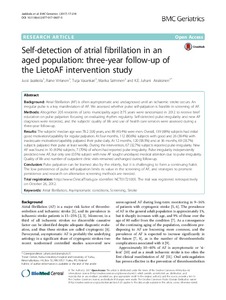Self-detection of atrial fibrillation in an aged population: three-year follow-up of the LietoAF intervention study
Marika Salminen; Tuija Vasankari; Jussi Jaakkola; K.E. Juhani Airaksinen; Raine Virtanen
Self-detection of atrial fibrillation in an aged population: three-year follow-up of the LietoAF intervention study
Marika Salminen
Tuija Vasankari
Jussi Jaakkola
K.E. Juhani Airaksinen
Raine Virtanen
BioMed Central Ltd.
Julkaisun pysyvä osoite on:
https://urn.fi/URN:NBN:fi-fe2021042717137
https://urn.fi/URN:NBN:fi-fe2021042717137
Tiivistelmä
Background
Atrial fibrillation (AF) is often asymptomatic and undiagnosed until an ischaemic stroke occurs. An irregular pulse is a key manifestation of AF. We assessed whether pulse self-palpation is feasible in screening of AF.
Methods
Methods
Altogether 205 residents of Lieto municipality aged ≥75 years were randomized in 2012 to receive brief education on pulse palpation focusing on evaluating rhythm regularity. Self-detected pulse irregularity and new AF diagnoses were recorded, and the subjects’ quality of life and use of health care services were assessed during a three-year follow-up.
Results
Results
The subjects’ median age was 78.2 [3.8] years, and 89 (43.4%) were men. Overall, 139 (68%) subjects had initial good motivation/capability for regular palpation. At four months, 112 (80.6%) subjects with good and 26 (39.4%) with inadequate motivation/capability palpated their pulse daily. At 12 months, 120 (58.5%) and at 36 months, 69 (33.7%) subjects palpated their pulse at least weekly. During the intervention, 67 (32.7%) subjects reported pulse irregularity. New AF was found in 10 (4.9%) subjects, 7 (70%) of whom had reported pulse irregularity. Pulse irregularity independently predicted new AF, but only one (0.5%) subject with new AF sought undelayed medical attention due to pulse irregularity. Quality of life and number of outpatient clinic visits remained unchanged during follow-up.
Conclusion
Conclusion
Pulse palpation can be learned also by the elderly, but it is challenging to form a continuing habit. The low persistence of pulse self-palpation limits its value in the screening of AF, and strategies to promote persistence and research on alternative screening methods are needed.
Kokoelmat
- Rinnakkaistallenteet [19207]
